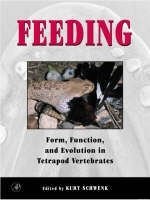
Feeding
Academic Press Inc (Verlag)
978-0-12-632590-4 (ISBN)
- Keine Verlagsinformationen verfügbar
- Artikel merken
As the first four-legged vertebrates, called tetrapods, crept up along the shores of ancient primordial seas, feeding was among the most paramount of their concerns. Looking back into the mists of evolutionary time, fish-like ancestors can be seen transformed by natural selection and other evolutionary pressures into animals with feeding habitats as varied as an anteater and a whale. From frog to pheasant and salamander to snake, every lineage of tetrapods has evolved unique feeding anatomy and behavior.
Similarities in widely divergent tetrapods vividly illustrate their shared common ancestry. At the same time, numerous differences between and among tetrapods document the power and majesty that comprises organismal evolutionary history.
Feeding is a detailed survey of the varied ways that land vertebrates acquire food. The functional anatomy and the control of complex and dynamic structural components are recurrent themes of this volume. Luminaries in the discipline of feeding biology have joined forces to create a book certain to stimulate future studies of animal anatomy and behavior.
Contributors
Preface
Section I Introduction
Chapter 1 Tetrapod Feeding in the Context of Vertebrate Morphology
I. Introduction
II. Approaches to the Study of Tetrapod Feeding
III. Concluding Comments
References
Chapter 2 An Introduction to Tetrapod Feeding
I. Introduction
II. Morphology of the Feeding Apparatus
III. Kinematics of Feeding:The Gape Cycle
IV. Kinematics of Feeding: Feeding Stages
V. Concluding Remarks
References
Chapter 3 Aquatic Feeding in Salamanders
I. Introduction
II. Morphology
III. Function
IV. Diversity and Evolution
V. Opportunities for Future Research
References
Chapter 4 Terrestrial Feeding in Salamanders
I. Introduction
II. Morphology
III. Function
IV. Diversity and Evolution
V. Opportunities for Further Research
References
Chapter 5 Feeding in Frogs
I. Introduction
II. Morphology of the Feeding Apparatus
III. Function of the Feeding Apparatus
IV. Neural Control of Prey Capture
V. Evolution of the Feeding Apparatus
VI. Conclusions
VII. Current and Future Directions
References
Chapter 6 Feeding in Caecilians
I. Introduction
II. Morphology
III. Function
IV. Evolution
V The Future
References
Section III Reptilia: Testudines
Chapter 7 A Bibliography of Turtle Feeding
I. Introduction
II. Bibliography
Section IV Reptilia: Lepidosauria
Chapter 8 Feeding in Lepidosaurs
I. Introduction
II. Lepidosaurian Phylogeny and Classification
III. Natural History
IV. Morphology of the Feeding Apparatus
V. Feeding Function
VI. Specialized Feeding Systems
VII. Evolution of Feeding in Lepidosaurs
VIII. Future Directions
References
Chapter 9 Feeding in Snakes
I. Introduction
II. Form and Function
III. Performance and Size
IV. Evolution
V. Concluding Remarks
References
Section V Reptilia: Archosauria
Chapter 10 Feeding in Crocodilians
I. Introduction
II. Morphology
III. Function
IV. Evolution
References
Chapter 11 Feeding in Paleognathous Birds
I. Introduction
11. Materials and Methods
III. Morphology of the Hyolingual Apparatus
IV. Function of the Hyolingual Apparatus
V Evolution of the Feeding System
References
Chapter 12 Feeding in Birds: Approaches and Opportunities
I. Introduction
II. Patterns of Analysis
III. Conclusion
References
Section VI Mammalia
Chapter 13 Feeding in Mammals
I. Introduction
II. Mammalian Feeding System
III. The "Process Model" for Mammalian Feeding
IV. Mechanical Properties and Textures of Foods
V. The Feeding Apparatus
VI. Feeding Function
VII. Control of Feeding Behaviors
References
Chapter 14 The Ontogeny of Feeding in Mammals
I. Introduction
II. Morphology
III. Function and Mechanics of Suckling
IV. Rhythmicity and Control of Suckling
V. Coordination of Swallowing and Respiration
VI. Transition from Suckling to Drinking at Weaning
VII. Evolutionary Considerations
References
Chapter 15 Feeding in Myrmecophagous Mammals
I. Introduction
II. Foraging Ecology
III. Morphology of the Feeding Apparatus
IV. Functional Morphology
V. Evolution of Myrmecophagous Specializations
VI. Directions for Future Research
References
Chapter 16 Feeding in Marine Mammals
I. Introduction
II. Feeding Strategies
III. Conclusions
References
Index
| Erscheint lt. Verlag | 3.8.2000 |
|---|---|
| Verlagsort | San Diego |
| Sprache | englisch |
| Maße | 216 x 279 mm |
| Gewicht | 1540 g |
| Themenwelt | Naturwissenschaften ► Biologie ► Evolution |
| Naturwissenschaften ► Biologie ► Zoologie | |
| ISBN-10 | 0-12-632590-1 / 0126325901 |
| ISBN-13 | 978-0-12-632590-4 / 9780126325904 |
| Zustand | Neuware |
| Haben Sie eine Frage zum Produkt? |
aus dem Bereich


